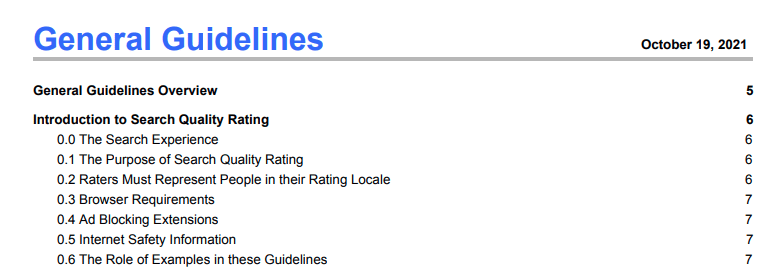The Google Quality Rater Guidelines - short QRG - are designed to help quality raters understand how Google thinks about quality. SEOs and Webmaster can use them to improve their websites so that they meet the requirements of the Search Engine and increase their visibility in searches.
The Google Quality Rater Guidelines are a document over 170 pages longwhich is used by Google's quality raters to evaluate the quality of websites, pages and search results. Our article will save you the time you would spend reading the entire document. I've included all the actionable information you need in the Google Quality Rater Guidelines you find, recorded. So instead of spending 3 hours reading the whole document, you can just spend 10 minutes reading my blog post here.
I ignore any advice that's specifically for quality raters and focus on anything that can really help you as an SEO, copywriter or Webmaster can help. Let's dive in.

Who are the Google Quality Raters?
Google works with external Search Quality Raters - a group of people who have been trained using the Quality Rater Guidelines.
The task of the quality assessors is to evaluate how well a website fulfills the Search Intention of Google users, based on the expertise, authority and trustworthiness of the website's content.
"These ratings have no direct influence on the Rankingbut they help us to measure the quality of our results and ensure that they meet a high standard all over the world."
Source: Google
The ratings collected by the Search Quality Raters are used to determine whether Google is providing a good service to its users. This information is particularly useful for Google after the Ranking-algorithm has been optimized - Google wants to know whether the changes are beneficial for users.
Your ratings don't affect the ratings of individual websites, but they do let Google know when some websites are ranking high when maybe they shouldn't.
Another purpose of the quality advisors is to provide additional data that is used to improve the algorithms:
"The evaluators also help us to categorize information in order to improve our systems. For example, we can ask what language a page is written in or what is important on a page."
Source: Google
The data provided by the Search Quality Raters The reviews collected are used to determine whether Google is providing a good service to its users. This information is particularly useful for Google after the Ranking-algorithm has been optimized - Google wants to know whether the changes are beneficial for users.
Your ratings don't affect the ratings of individual websites, but they do let Google know when some websites are ranking high when maybe they shouldn't.
Another purpose of the quality advisors is to provide additional data that is used to improve the algorithms:
"The raters also help us to categorize information in order to improve our systems. For example, we can ask what language a page is written in or what is important on a page."
Source: Google

https://static.googleusercontent.com/media/guidelines.raterhub.com/en//searchqualityevaluatorguidelines.pdf available.
What can be learned from the Google Quality Rate Guidelines?
The Google Quality Rater Guidelines are a helpful resource for anyone who owns or maintains a website. By seeing what quality raters are looking for when evaluating our sites, we can tailor our content to what Google considers quality.
The people at Google want to constantly improve search quality. They strive to match the user's intent for each search query and deliver the best matching results that are of the highest quality.lity.
In 2015, Google launched the Google search quality guidelines which is beneficial for anyone with a website - you can look at the quality raters' priorities and adjust your website to their expectations.
Quality assessors generally have 3 Tasks:
- Assessment of the quality of websites,
- Ensure that the mobile results are helpful, and
- Check whether queries generally deliver good results.
The Google Quality Rate Guidelines are structured accordingly:
- The first section is the most important for anyone who wants to make their website visible in searches by improving the quality of their website.
- The second section is an overview of the needs of mobile users.
- And the third section, "Requirements met", is about how well the algorithms currently used to achieve the best possible results work. Search results (with a focus on mobile search).
So let's start with the quality and explore the first 70 pages...
Quality according to the Quality Rater Guidelines
Quality raters check the following six elements to assess the quality of a website:
1. the purpose of the site
The simplest definition of the purpose is why the page was created.
Ideally, the purpose should be useful, i.e. it should help people. Some have other purposes, such as making money, running scams or spreading misinformation.
Here are some examples of useful page purposes:
- the exchange of information, media or software,
- Express opinions and points of view or allow others to express them,
- Entertainment, and
- E-commerce.
To assess the quality of a page, the quality raters evaluate how well it fulfills its purpose.
If there is no benefit for users, the page is automatically given the lowest rating without further review.
2. the content of the page
Different parts of the content serve different purposes, and to judge the content of a page, you need to know what you're looking at.
It would be silly to penalize a site for opinions that have nothing to do with the topic, as it is user-generated content.
But if the comments section is completely unmoderated and offensive content, spamming links or other things that have nothing to do with the actual purpose, this could harm your rating.
Let's take a look at the three categories of content that the QRG manual distinguishes.
The main content
Main content is all content that serves to help the site to fulfill its purpose. It can be created by webmasters, authors or users.
The supplementary contents
Supplementary content serves to improve the user experience. This includes comment sections, media handles, internal links to related articles, etc. On the YouTube interface, for example, everything that is not the video itself or an ad is additional content.
The displays
The last component of the content of a website is advertising. This means anything that is sponsored. The presence of ads does not contribute to the quality of the page, because Google understands Content-Marketing.
Sponsoring is a promising way to earn money and keep a high-quality website running. However, advertising must be clearly labeled and separated from all other content. They can even help the site fulfill its purpose if they are closely related to the theme.
Either way, the advertising should not be distracting or difficult to close.
All in all, the Google Quality Rater Guidelines state the following:
- What helps the site fulfill its purpose is the main content,
- what is sponsored is advertising, and
- Everything that is left behind is additional content.
3. your money or your life (YMYL) pages
If the content of a page can affect a person's happiness, health, finances or safety, the page is considered YMYL.
Sogenannte „Your Money your Life“, kurz YMYL-Seiten, haben strengere Richtlinien, wenn es um die Qualität und vor allem um die E-A-T-assessment. We will go into this in more detail below.
The categories described in the QRG include the following:
- News and current events,
- Civics, government and law,
- Finances,
- Shopping,
- Health and safety,
- Groups of people, and others.
These pages were the most affected by the latest algorithm updates, starting with the Medic update in August 2018.
4. the E-A-T evaluation
E-A-T stands for expertise, authority and trustworthiness (Trust). This term is mentioned over 120 times in the Quality Evaluator Guidelines in the latest version dated October 14, 2020.
This concept is particularly important for the YMYL pages, but not only there.
To E-A-T To put it practically, a trustworthy website should be reliable:
- Have the content written by experts who have a deep understanding of the topic in question
- Showcase the expertise of all contributing authors
- Be a reliable source of information that is trusted by other reputable sources in the same field.
If it is a medical site, people with a medical degree should contribute to it. A website that offers tax advice could use the opinions of accountants. Review sites should be written by people who have actually used the products or services.
But not all content has to be written by experts with academic degrees.
In the Google Quality Rater Guidelines this is called "everyday experience". You can even have them in YMYL themes. This can be a real-life experience with an illness, for example. Patient testimonials can be very helpful for users.
Finally, websites and creators should be respected in real life to fulfill the requirement of authority. This can take the form of Backlinks or citations on third-party websites. The rule of thumb is that better sites get more links and mentions.
It's also a good idea to brag about awards, rewards and conference appearances by members of your team. The QRG says that quality raters should "find out what independent sources say about the site".
A high E-A-T-rating is awarded for pages that
- Cite sources properly,
- Author biographies and references included,
- Hire authors who are experts in the respective field, and
- have a good reputation and good ratings.
5. authorship & monetization of content
Next, Google quality raters look at where the information comes from. Try to provide answers to the following questions on your website:
- Who created the content of the page?
- Who provides offers?
- Where does the funding come from?
- Who is responsible for the website?
It is important that users know who owns the website and who maintains it.
Websites should always do their best to provide this information and make it easily accessible. For example:
- Create About or Contact pages. If for some reason you don't want these pages on your website, you can place the authorship information in an FAQ section or in special articles.
- Provide information on monetization. A public partnership policy increases the trustworthiness of a website.
6. reputation research
The reputation of a website is based on the experiences of real users and the opinion of experts in the field. When examining the reputation, the quality assessors not only look at the website, but also at how the company or business is perceived outside the website. If the creator of the MC is not the same as the creator of the website, the quality assessors must also examine the reputation of the creator.
A rating rubric is great, but quality raters are instructed to look for information in a variety of sources, including third-party websites. That's why it's important to take care of your reputation everywhere.
Notice: Don't remove negative comments or reviews about your business from your website. Even if it seems like a good idea, this is a bad practice for which you could be penalized by Quality Raters.
News and informational articles are considered good sources of information about the reputation of websites and their operators. Quality raters look for awards or other forms of recognition as well as possible controversies. Biographical information can be considered when researching individual authors. It must, of course, be possible to verify this information.
A lack of information about a website's reputation is not necessarily a bad thing. Many small local businesses have no more than 2 to 3 reviews or user accounts. That's fine. Promoting positive reviews through discount offers or, even worse, writing completely fake reviews (or hiring someone to do so) can lead to a significant drop in your quality score.

Quality raters use information that is appropriate for the website being rated. For example, the reputation of YMYL content or creators must come from experts in the relevant YMYL topic.
The evaluation of page quality
A page can receive a low, low+, low, low+, medium, medium+, high, high+ or highest quality rating.
The most important factors that influence your quality rating include:
- the purpose and how well the page achieves it,
- the E-A-T Rating,
- the quality and scope of the main content,
- who is the author of the main content (and whether this information exists), and
- the reputation of the site.
Pages with the lowest quality vs. pages with the highest quality
In summary, there are a few things you should strive to do according to the Quality Rater Guidelines, and others you should avoid:
Pages with the lowest quality:
- Harming yourself or other people: Physically, mentally, emotionally, financially
- Spreading hatred or violence against certain groups of people
- Misleading information that can be easily refuted by generally recognized facts
- Misleading information that can cause harm to people
- Lowest E-A-T Reviews
- Hidden or false information about the website
- Suspected malicious behavior, including fraud & phishing for personal information
- Hacked, defaced or spammed pages
- Automatically created or copied Content
Highest quality pages:
- Very high quality main content
- Clear and satisfactory information on the website: about, contact and customer service
- Very positive reputation, very high level of E-A-T
- Suitable for display and use on mobile devices
That's about 68 pages of the QRG. The next 19 pages deal with the topic of understanding mobile user needs.
Mobile friendliness is becoming increasingly important
According to the Google Quality Rater Guidelines has a mobile friendly website:
- No software that is not compatible with mobile devices,
- a text size that is optimal for reading without zoom,
- Content that adapts to the screen, and
- Links with an appropriate size of the clickable area.
It's worth investing some time and even money to make sure your website meets the above criteria.
This is because in 2019, a good 60 % of searches will be conducted on cell phones. Even more - even on desktop - 70 % of the Search results on the first page are always mobile-friendly. To rank high, you need to make sure that smartphone users can find the information on your website quickly.
For the same reason, the transition to the Mobile-first indexing means that websites that are not optimized for these devices will lose out. How so? Basically, any content that isn't available on the mobile version won't get a Traffic bring
Imagine leaving out your About or Contact pages in the mobile version. Googlebot will interpret this as a lack of information on the subject! Algorithms aimed at increasing the rank of pages with high E-A-T will penalize your site.
Have the expectations been met?
The last 80 pages, which contain valuable information for "non-quality assessors", revolve around the "Needs Met Scale". It is about assessing the quality and Relevance of search results.
A SERP-The result can be Not Applicable, Fully Met (FullyM), Very Met (HM), Moderately Met (MM), Slightly Met (SM) and Failed (FailsM).
This can affect both the block (snippet) that is displayed in the SERPs and the content of the page. If a page is displayed as a Rich Result (special blocks with special content, such as images, FAQs, price, etc.) is displayed, the Google Search Quality Raters to assess whether a user would click on the link. If not, only the content block is evaluated.
The most important factors that influence your demand coverage include
- the request is answered accurately and completely,
- Information is relevant,
- the site is mobile friendly and
- the page quality rating is high.
Unfulfilled results vs. fully fulfilled results
Not fulfilled does not mean that the page is less visible overall, but only for unrelated search queries. Google just wants to make sure they are pushing the content that matches the search query. For the search queries you are trying to answer, you will definitely rank highly for fulfilled receive
A note on adult content, foreign, broken & offensive sites
When assessing the criterion "Requirements met", the quality assessors assign "Porn", "Foreign language" and "Not loaded" to the result blocks if this is appropriate. Some assessment tasks also require the marking of "offensive" and/or "not suitable for everyone" results. This does not necessarily mean a penalty.
A site with adult content can still be a quality site, but the quality raters must mark it as "not for everyone".
Pornographic content is considered pornographic, regardless of whether it is contained in links, texts, images, etc, Pop-ups or conspicuous ads appear. Some content may be considered porn in one place but not in another.
"This flag should be used if the content within the results block or the content on the LP is pornographic, including pornographic images, links, text, Pop-ups and/or conspicuous porn ads. An image may be considered pornographic in one culture or country but not in another."
Google does its best to avoid showing users explicit content when they are not specifically looking for it. If you come across a pornographic site, it's often a bad experience when you're looking for something else entirely.
If the purpose of your website is to provide explicit content, you don't need to worry about it being categorized as "not fulfilled" for unrelated search queries. You probably want your users to actively search for the content anyway.
A detailed summary of the Google Quality Rater Guidelines
This is a long article that summarizes an even longer document. Here are the most important points from the Google Quality Rate Guidelines:
- Create very high quality main content, better than your competitors.
- Provide information on your website about who is responsible for creating the content and where the money comes from.
- Don't write fake reviews or mislead your customers with bad practices. Instead, make sure that you offer your customers the best possible service. This will earn you positive reviews.
- Choose your Content-authors carefully. They should all be masters in their field, whether through academic honors or daily experience.
- Make sure your website is mobile-friendly. If your pages aren't formatted properly, you're missing out on a lot of visibility on mobile devices.
- Use Structured data good. The display of rich results is good press.
- Do not spread the content over several "pages" that users have to click through. It is bad practice to generate empty clicks that are not useful or helpful to users.
- And the most important thing: keep an eye on your users. Google wants to display content that is helpful. If you keep that in mind, you should be in a good position!
The change log of the Google Quality Rater Guidelines
Google updates the Google Quality Rater Guidelines over time.
By keeping up to date with the changes, you can see the direction Google is going in and better understand what makes a good website. By comparing the updates with the previous versions, you can learn more about Google's intentions in the Ranking experienced by websites.
Here is a Table from Google with a summary of the changes that have been made over time:
| Date of publication | Summary of the changes |
| October 2021 | 1) The definition of the YMYL subcategory "Groups of people" has been expanded. 2) Updated guidance on researching reputation information for websites and content creators 3) Restructure and update the "Lowest page quality" section; restructure and refresh the examples to reflect the new structure 4) Simplified definition of "offensive" to eliminate redundancies with the "Lowest page quality" section 5) Minor changes (screenshots and URLs, wording and examples have been updated, outdated examples removed, typos corrected, etc.) |
| October 2020 | 1) Note added to clarify that ratings have no direct influence on the order of the Search results have 2) The role of examples in these guidelines highlighted as a separate section in the introduction 3) Clarification added that special content result blocks can have links to landing pages 4) Updated guidance on how to evaluate pages with malware warnings and when to assign the "Do not load" flag 5) The order of the section "Evaluation indicators" and the section "Relationship between page quality and fulfilled demand" has been changed to provide clarity. 6) Added "Rating of dictionary and encyclopedia results for different queries": Emphasizes the importance of understanding the user's intent and the query for Needs Met Rating. 7) Minor changes throughout the text (updated examples and explanations for more consistency; simplified wording regarding raters representing people in their country; correction of typos; etc.). 8) Updated information on how to evaluate pages with malware warnings and when the "Do not load" flag should be assigned. |
| December 2019 | 1) Added "Introduction to search quality assessment": Describes the overall user experience of searching and the purpose of the search quality score 2) Definitions and clarifications added to explain important search concepts 3) Minor changes throughout the text (outdated QR code has been removed, language has been revised to ensure consistency between sections, typos have been corrected, etc.) |
| September 2019 | 1) Revised definition of "Your Money or Your Life (YMYL)" to include more detailed subcategories; changed YMYL labels in the page quality examples to align with the new definition 2) Additional information on distinguishing between different types of content on websites 3) Emphasized that the original content can justify the highest page quality and added an illustrative example; updated existing PQ example ratings and explanations accordinglyMinor changes throughout the text |
| May 2019 | 1) The slider for the E-A-T-The PQ rating has been renamed the Page Quality (PQ) slider to emphasize the holistic concept of quality; the instructions and examples for the PQ rating have been updated to ensure consistency and clarity. 2) Minor language and screen updates to reflect program changes and technical changes to the rating platform interface |


